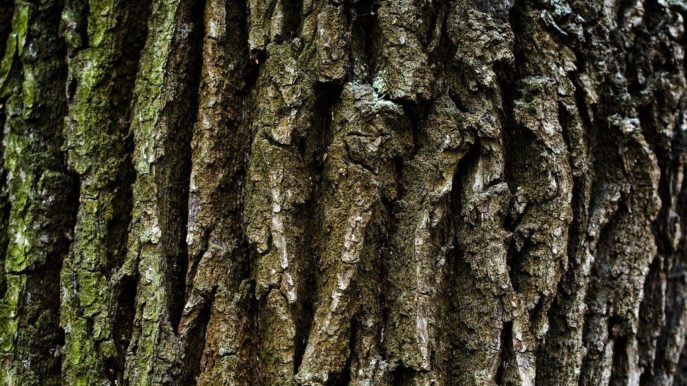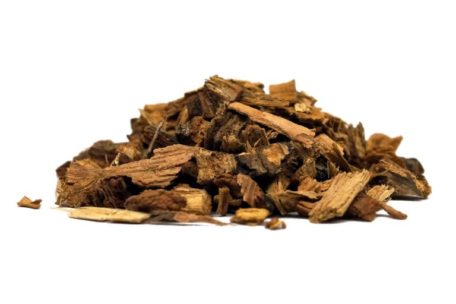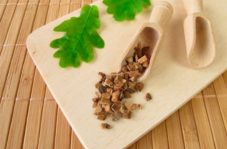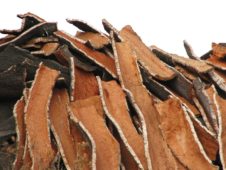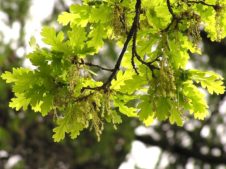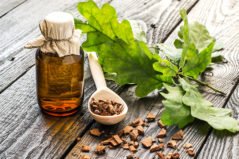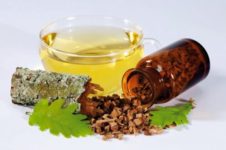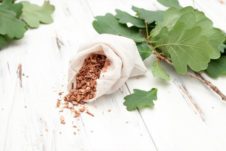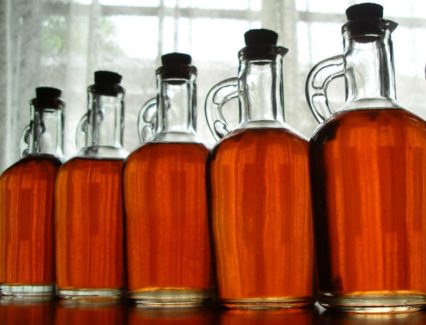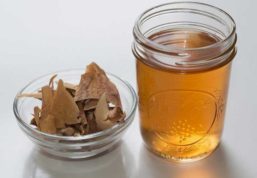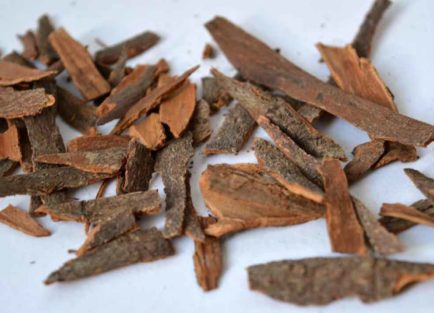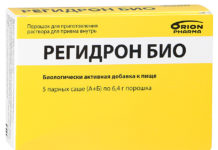Traditional medicine knows many secrets of health, beauty and youth. One of the simple and effective cures for “one hundred diseases” is oak bark, the medicinal properties and contraindications of which should be known to everyone who cares about their own health. The ability to correctly use this simple tool will help strengthen the whole body as a whole and get rid of a number of diseases.
Material Content:
The healing properties of oak bark
Many in vain consider oak bark an outdated folk remedy. In fact, this component is often included in various preparations of modern pharmaceuticals. This is due to the specific composition of oak bark, which contains:
- protein compounds, glucose, flavonoids;
- tannins;
- pentosans;
- pectins;
- catechins.
The main property of tannins, due to which they are widely used in medicine, is the elimination of the harmful effects of pathogenic microorganisms. This explains the anti-inflammatory and bactericidal action. According to various sources, oak bark contains from 15 to 20% of these substances. Also, tannins help relieve inflammation of the mucosa and have a hemostatic effect.
Pentosans are polysaccharides with antigenic properties. They help to produce antibodies to certain types of bacteria and microorganisms, have a general strengthening effect and improve the functioning of the immune system. Pentosans stop the inflammatory process.
Pectin is a type of polysaccharide that has a positive effect on the gastrointestinal tract. They inhibit the growth of microbial microflora in the intestine, normalize the digestive system, and contribute to the restoration of normal microflora.These substances are used both for treatment and for the prevention of diseases of the gastrointestinal tract, including acid-dependent disorders (chronic and erosive gastritis, gastric ulcer).
Catechins are a potent antioxidant needed to protect against free radicals, slow down the aging process, and strengthen the body overall.
Properties of oak bark:
- antimicrobial;
- anti-inflammatory;
- astringent;
- wound healing;
- hemostatic.
The tool is used in many branches of medicine, and is also successfully used in cosmetology, for example, to strengthen hair and improve scalp.
The catechins in the composition provide an oncoprotective effect.
Oak bark is quite difficult to harvest on your own. The quality of the raw materials used in the treatment of various diseases has special requirements, therefore it is easier to purchase dried and crushed bark in any pharmacy.
What diseases are used for?
The bark has found application in various branches of medicine. It is used both internally and externally.
- As a medicine for oral administration, the cortex is taken for indigestion. As an adjuvant, it can be used even with infectious diseases of the gastrointestinal tract, for example, with gastric (intestinal) flu. Due to astringent and anti-inflammatory properties, the bark is used for gastritis, but not in the acute phase.
- Outwardly, a decoction and infusion of the cortex is used to accelerate the healing of wounds and burns. The bactericidal effect of the drug in this case helps to avoid infection of the wound.
- On the basis of the bark, rinse and hair masks are prepared that strengthen the hair follicles, promote rapid growth, have a positive effect on the scalp and help in the treatment of dandruff.
- As compresses and lotions, the drug is used for hyperhidrosis, reducing sweating and helping to combat the unpleasant odor of sweat.
- Another indication for the use of the product is baths for the legs and hands for fungal infections of the skin and nails (mycoses and onychomycoses). Bark promotes protein denaturation, thereby helping to defeat pathogenic microflora.
- Due to the same fungicidal effect, the drug is used in gynecology, to combat thrush and restore vaginal microflora.
- The main indication for use is diseases of the oral cavity and gums. Moreover, oak bark extract is contained in the most effective therapeutic rinses and toothpastes available in pharmacies. This tool is recommended for periodontal disease, bleeding gums, gingivitis and stomatitis.
- Infusions and decoctions can be used to rinse the throat with tonsillitis, thanks to antiseptic and astringent properties.
Oak bark for diarrhea should be used with caution. Prolonged use of the drug inside can lead to a decrease in the acidity of the stomach. With constipation, infusions and decoctions of the bark are prohibited.
Oak bark: instructions for use
Using the product is quite simple, the main thing is to properly prepare the medicine. It is easier to buy raw materials in a pharmacy, since it is very problematic to procure it yourself. For treatment, apply:
- infusion or decoction;
- alcohol tincture (extract);
- ointment from dried bark.
Infusion and decoctions are used for oral administration, mouthwash, douching and hair care. Alcohol tincture is a means to combat diarrhea and intestinal effects.
Many people advise using alcohol tincture to combat acne on the face, but it must be applied pointwise. Otherwise, you can "burn" the skin with alcohol.
Ointment from the bark is used to restore the skin with wounds and burns. It accelerates regeneration, helps prevent scar formation.
Infusion and decoction
The easiest way to prepare a medicine is an infusion. Cooking is unnecessary. For cooking, pour raw materials with boiling water, cover and wrap with a towel. Insist medicine should be two hours. The easiest way to prepare an infusion in a thermos. Recommended proportions - 2 parts of raw materials to 5 parts of water.Instructions for use inside is universal - a tablespoon of infusion 4 times a day. This regimen is practiced for diarrhea and other disorders of the digestive tract.
Broth is a more concentrated remedy. It is recommended to use to rinse the mouth and throat with angina. For cooking, take 1 part of the raw material in 10 parts of water and cook on low heat for 15-20 minutes. In this case, it is important to prevent constant boiling of the medicine. After 20 minutes, the product is covered with a lid and left to cool completely.
With diarrhea and diarrhea, a decoction is drunk on a teaspoon up to 6 times a day. Rinse the mouth or throat twice a day. Oak bark for gums can also be used as applications. To do this, a cotton swab is moistened in the broth and applied to the inflamed areas for 5 minutes.
With hyperhidrosis, lotions or compresses are used. To do this, moisten a piece of gauze or bandage in the broth and apply it to the area with increased sweating for 10 minutes. When sweating feet and foot fungus, use baths. In 4 liters of hot water I dissolve a glass of broth, and place the feet for 20 minutes.
Alcohol tincture or oak bark extract
The exact proportions for the preparation of tinctures are different for everyone. There are two recipes - more concentrated (40 g of raw materials per 100 ml of alcohol), and sparing (two tablespoons per 200 ml of vodka). The ingredients must be mixed in a glass container made of opaque glass, corked with a lid and left for two weeks in a dark room. Shake the container daily.
A concentrated composition is usually called an extract. With diarrhea, it is taken 10 drops twice a day. If the tincture was prepared on vodka, the dosage is doubled - 20 drops in the morning and evening.
Ointment from the bark
To prepare the ointment, you must first grind the bark into powder in a blender or coffee grinder. There are several recipes for its preparation.
- For burns and superficial wounds, a butter-based product is used. To do this, you need to slightly warm the oil and pour 10 g of crushed bark powder into it. Then the mixture must be rinsed in a water bath for half an hour. The ointment is poured into a convenient jar and stored in the refrigerator. Use - as needed, since with external use, the risk of side effects is minimal.
- With dermatitis, mycoses and bedsores, an ointment with zinc is used. One and a half tablespoons of crushed powder bark pour 50 ml of boiling water and insist hour. Then the product is mixed with 100 ml of zinc ointment. The drug is applied to problem areas under a compress for 5 minutes, and then washed off with water.
Oak bark is not used for psoriasis and allergic eczema, as it can provoke an exacerbation of the disease.
Face and hair application
To care for problem skin, you can use lotion. To do this, you need to prepare an alcohol tincture according to the recipe described above and mix it with water in a proportion of 1:10. The product is recommended for teenage skin.
At an older age, tincture can be used pointwise with the appearance of inflammation on the face. In this case, the medicine is mixed in half with water, and then applied with a cotton swab strictly to the pimple.
For hair, use a decoction or infusion. They just rinse your hair every time after washing.
Oak bark is more suitable for brown-haired women and brunettes, as it has a light tinting effect. Moreover, daily rinsing with concentrated broth (50 g of bark for 2 liters of boiling water) will give the hair a persistent chestnut shade.
In case of hair loss, the product is applied to the scalp for two hours, and then washed off with water. An excellent remedy for hair loss is a mixture of heated burdock oil with a decoction of oak bark, taken in equal proportions. This mask should be kept for 2-3 hours.
The benefits and harms of pregnancy
The tool can be used for douching the vagina with thrush and dysbiosis (bacterial vaginosis), including pregnant women. For this purpose, use infusion, douching is carried out from two to four times a day.
Before using this method, you should consult your doctor.
Pregnancy is an absolute contraindication for the internal intake of tincture, decoction or infusion of oak bark. This is due to the fact that any herbal remedies are potentially dangerous with the risk of increasing uterine tone.
Despite the large number of medicinal properties and undeniable health benefits, oak bark should be used carefully. Among the contraindications:
- continuous use for longer than two weeks;
- individual intolerance;
- age up to three years;
- pregnancy;
- constipation
- hemorrhoids;
- ulcer or erosive gastritis during exacerbation.
It is important to remember that not a single folk remedy can replace an adequate therapy prescribed by a qualified specialist. Before self-medication, you should consult your doctor.





